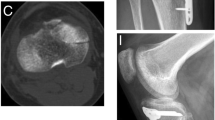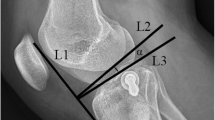Abstract
Background
Tibial plateau fractures (TPFs) are the most common among periarticular fractures. Mechanism of injuries is most from varus/valgus and flexion injury. Hyperextension type injuries are rare and easily to be overlooked. We reported 12 cases of this fracture type. Complications of early cases were reported, and treatment strategies of late cases were suggested.
Materials and methods
From 2010 to 2016, we performed a retrospective analysis of 248 cases of TPFs in our institute and 12 cases of hyperextension bicondylar TPFs were diagnosed. Diagnostic method is from both plain films and CT scans. The features of this injury included sagittal plane malalignment with loss of the normal posterior slope of the tibial plateau, tension failure of the posterior cortex, and compression of the anterior cortex. Surgical approach is predominantly via an anterolateral and/or posteromedial double incision at the first. Then anteromedial with adequate grafting to support the bone defect was modified. Postoperative radiographic analysis, physical examination findings, and complications were reported. Patient reported outcome scores from the Knee Injury and Osteoarthritis Outcome Score (KOOS) were recorded.
Results
Twelve patients were followed up for a mean period of 16.6 months (range 12–26 months). The mean time to radiographic bony union was 3.6 months (range 3–9 months, SD 8.5). About complications, the incidence of popliteal artery occlusion received PTA was 8% (1/12). And 3/12 (25%) patients had either partial or complete peroneal nerve injury. 2/12 (16%) patients developed a leg compartment syndrome. 33% (4/12) demonstrated associated injuries including posterolateral complex injuries mostly and posterior cruciate ligament avulsion fracture in one case. The average range of motion of the affected knees was 3.4–130° postoperatively. Analysis of complication about surgery included inadequate reduction and fixation in two cases, insufficient bone grafting in one case. The mean mPTA was significantly improved after fixation (preoperative 82° postoperative 3 months 86°). The mean posterior slope (PTA) was preoperative − 3° and postoperative 3 months 3°. And mean KOOS was 80.
Conclusions
Hyperextension bicondylar tibial plateau fractures show a special characteristic of changes in posterior tibial slope angle and are easy to be overlooked. Complication rate is high after injury and after ineffective fixation. Choosing correct approach with sufficient grafting and stable fixation for treatment of hyperextension bicondylar tibial plateau fractures should be used to improve patients’ outcome.






Similar content being viewed by others
References
Schatzker J, McBroom R, Bruce D (1979) The tibial plateau fracture. the Toronto experience 1968–1975. Clin Orthop Relat Res 138:94–104
Luo CF, Sun H, Zhang B, Zeng BF (2010) Three-column fixation for complex tibial plateau fractures. J Orthop Trauma 24:683–692
Wang Y, Luo C, Zhu Y, Zhai Q, Zhan Y, Qiu W, Xu Y (2016) Updated Three-column concept in surgical treatment for tibial plateau fractures—a prospective cohort study of 287 patients. Inj Int J Care Inj 47:1488–1496
Hua K, Jiang X, Zha Y, Chen C, Zhang B, Mao Y (2019) Retrospective analysis of 514 cases of tibial plateau fractures based on morphology and injury mechanism. J Orthop Surg Res 14(1):267
Yao X, Xu Y, Yuan J et al (2018) Classification of tibia plateau fracture according to the "four-column and nine-segment". Injury 49(12):2275–2283
Zhao R, Lin Z, Long H, Zeng M, Cheng L, Zhu Y (2019) Diagnosis and treatment of hyperextension bicondylar tibial plateau fractures. J Orthop Surg Res 14(1):191
Xie X, Zhan Y, Wang Y, Lucas JF, Zhang Y, Luo C (2020) Comparative analysis of mechanism-associated 3-dimensional tibial plateau fracture patterns. J Bone Joint Surg Am 102:410–418
Firoozabadi R, Schneidkraut J, Beingessner D, Dunbar R, Barei D (2016) Hyperextension varus bicondylar tibial plateau fracture pattern: diagnosis and treatment strategies. J Orthop Trauma 30(5):e152–e157
Wu K, Huang J, Lin J, Wang Q (2017) Diagnosis and treatment of anterior tibial plateau fracture-dislocation: a case series and literature review. J Knee Surg 30(2):114–120
Prat-Fabregat S, Camacho-Carrasco P (2016) Treatment strategy for tibial plateau fractures: an update. EFORT Open Rev 1(5):225–232
Acknowledgement
The authors thank Miss Lin Chih Yang, for preparation of the diagrams and Miss Chen Yi Tzu for the accomplishment of the tables. Without their help, the article wouldn’t be completed.
Funding
There is no funding source.
Author information
Authors and Affiliations
Corresponding author
Ethics declarations
Conflict of interest
The authors declare that they have no conflict of interest.
Ethical approval
This article does not contain any studies with human participants or animals performed by any of the authors.
Additional information
Publisher's Note
Springer Nature remains neutral with regard to jurisdictional claims in published maps and institutional affiliations.
Rights and permissions
About this article
Cite this article
Lin, K.C., Tarng, YW. A strategy to prevent complications of hyperextension type tibial plateau fracture. Eur J Orthop Surg Traumatol 31, 71–78 (2021). https://doi.org/10.1007/s00590-020-02739-7
Received:
Accepted:
Published:
Issue Date:
DOI: https://doi.org/10.1007/s00590-020-02739-7




